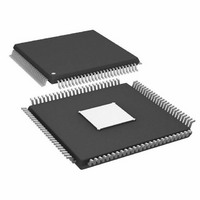AD9910BSVZ Analog Devices Inc, AD9910BSVZ Datasheet - Page 32

AD9910BSVZ
Manufacturer Part Number
AD9910BSVZ
Description
IC DDS 1GSPS 14BIT PAR 100TQFP
Manufacturer
Analog Devices Inc
Datasheet
1.AD9910BSVZ-REEL.pdf
(64 pages)
Specifications of AD9910BSVZ
Design Resources
Synchronizing Multiple AD9910 1 GSPS Direct Digital Synthesizers (CN0121)
Resolution (bits)
14 b
Master Fclk
1GHz
Tuning Word Width (bits)
32 b
Voltage - Supply
1.8V, 3.3V
Operating Temperature
-40°C ~ 85°C
Mounting Type
Surface Mount
Package / Case
100-TQFP Exposed Pad, 100-eTQFP, 100-HTQFP, 100-VQFP
Pll Type
Frequency Synthesis
Frequency
1GHz
Supply Current
29mA
Supply Voltage Range
1.71V To 1.89V
Digital Ic Case Style
TQFP
No. Of Pins
100
Operating Temperature Range
-40°C To +85°C
Lead Free Status / RoHS Status
Lead free / RoHS Compliant
For Use With
AD9910/PCBZ - BOARD EVAL FOR AD9910 1GSPS
Lead Free Status / RoHS Status
Lead free / RoHS Compliant, Lead free / RoHS Compliant
Available stocks
Company
Part Number
Manufacturer
Quantity
Price
Company:
Part Number:
AD9910BSVZ
Manufacturer:
AVAGO
Quantity:
1 400
Company:
Part Number:
AD9910BSVZ
Manufacturer:
ADI
Quantity:
509
Company:
Part Number:
AD9910BSVZ
Manufacturer:
Analog Devices Inc
Quantity:
10 000
Part Number:
AD9910BSVZ
Manufacturer:
ADI/亚德诺
Quantity:
20 000
Company:
Part Number:
AD9910BSVZ-REEL
Manufacturer:
Analog Devices Inc
Quantity:
10 000
AD9910
No-Dwell Ramp Generation
The two no-dwell bits in Control Function Register 2 add to the
flexibility of the DRG capabilities. During normal ramp generation,
when the DRG output reaches the programmed upper or lower
limit, it simply remains at the limit until the operating parameters
dictate otherwise. However, during no-dwell operation, the DRG
output does not necessarily remain at the limit. For example, if the
digital ramp no-dwell high bit is set when the DRG reaches the
upper limit, it automatically (and immediately) snaps to the lower
limit (that is, it does not ramp back to the lower limit; it jumps to
the lower limit). Likewise, when the digital ramp no-dwell low bit is
set, and the DRG reaches the lower limit, it automatically (and
immediately) snaps to the upper limit.
During no-dwell operation, the DRCTL pin is monitored for state
transitions only; that is, the static logic level is immaterial.
During no-dwell high operation, a positive transition of the
DRCTL pin initiates a positive slope ramp, which continues
uninterrupted (regardless of any further activity on the DRCTL
pin) until the upper limit is reached.
During no-dwell low operation, a negative transition of the DRCTL
pin initiates a negative slope ramp, which continues uninterrupted
(regardless of any further activity on the DRCTL pin) until the
lower limit is reached.
Setting both no-dwell bits invokes a continuous ramping mode
of operation; that is, the DRG output automatically oscillates
between the two limits using the programmed slope parameters.
Furthermore, the function of the DRCTL pin is slightly different.
Instead of controlling the initiation of the ramp sequence, it
only serves to change the direction of the ramp; that is, if the
DRG output is in the midst of a positive slope and the DRCTL
pin transitions from Logic 1 to Logic 0, then the DRG imme-
diately switches to the negative slope parameters and resumes
oscillation between the limits. Likewise, if the DRG output is in
the midst of a negative slope and the DRCTL pin transitions from
Logic 0 to Logic 1, the DRG immediately switches to the positive
slope parameters and resumes oscillation between the limits.
When both no-dwell bits are set, the DROVER signal produces a
positive pulse (two cycles of the DDS clock) each time the DRG
output reaches either of the programmed limits (assuming that the
DROVER pin active bit is set).
A no-dwell high DRG output waveform is shown in Figure 40.
The waveform diagram assumes that the digital ramp no-dwell
high bit is set and has been registered by an I/O update. The
status of the DROVER pin is also shown with the assumption
that the DROVER pin active bit has been set.
Rev. C | Page 32 of 64
DRG OUTPUT
The circled numbers in Figure 40 indicate specific events, which
are explained as follows:
Event 1—Indicates the instant that an I/O update registers that the
digital ramp enable bit has been set.
Event 2—DRCTL transitions to a Logic 1, initiating a positive
slope at the DRG output.
Event 3—DRCTL transition to a Logic 0, which has no effect on
the DRG output.
Event 4—Because the digital ramp no-dwell high bit is set,
the moment that the DRG output reaches the upper limit, it
immediately switches to the lower limit, where it remains
until the next Logic 0 to Logic 1 transition of DRCTL.
Event 5—DRCTL transitions from Logic 0 to Logic 1, which
restarts a positive slope ramp.
Event 6 and Event 7—DRCTL transitions are ignored until the
DRG output reaches the programmed upper limit.
Event 8—Because the digital ramp no-dwell high bit is set, the
moment that the DRG output reaches the upper limit, it immedi-
ately switches to the lower limit, where it remains until the next
Logic 0 to Logic 1 transition of DRCTL.
Operation with the digital ramp no-dwell low bit set (instead of the
digital ramp no-dwell high bit) is similar, except that the DRG
output ramps in the negative direction on a Logic 1 to Logic 0
transition of DRCTL and jumps to the upper limit upon reaching
the lower limit.
DROVER Pin
The DROVER pin provides an external signal to indicate the status
of the DRG. Specifically, when the DRG output is at either of the
programmed limits, the DROVER pin is Logic 1; otherwise, it is
Logic 0. In the special case of both no-dwell bits set, the DROVER
pin pulses positive for two DDS clock cycles each time the DRG
output reaches either of the programmed limits.
DROVER
DRCTL
1
P DDS CLOCK CYCLES
Figure 40. No-Dwell High Ramp Generation
2
+Δ
t
LOWER LIMIT
3
STEP SIZE
POSITIVE
4
5
UPPER LIMIT
6
7
8















